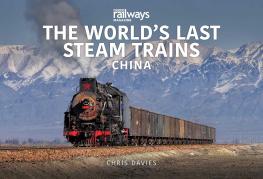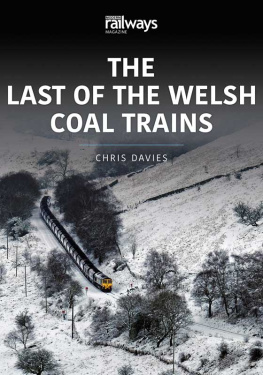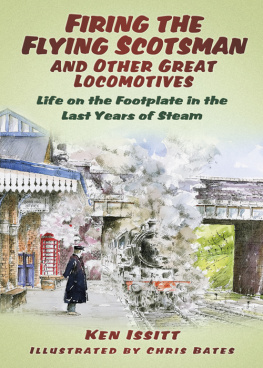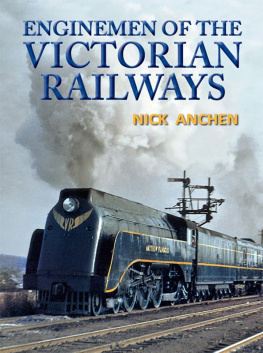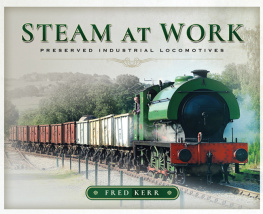Title Page Image: The winter sun dips below the horizon at the Wulong dump as an SY Class locomotive, laden with mine waste, slowly makes its way up the incline to dispose of the waste. 3 December 2015.
Contents Page Image: JS 8225 arrives at the wash plant with another load of coal for processing the Tian Shan Mountains are in the distance. 6 December 2015.
Published by Key Books
An imprint of Key Publishing Ltd
PO Box 100
Stamford
Lincs PE19 1XQ
www.keypublishing.com
The right of Chris Davies to be identified as the author of this book has been asserted in accordance with the Copyright, Designs and Patents Act 1988 Sections 77 and 78.
Copyright Chris Davies, 2020
ISBN 9781913295974
ePub e-book ISBN 9781802820652
20 21 22 23 24 10 9 8 7 6 5 4 3 2 1
All rights reserved. Reproduction in whole or in part in any form whatsoever or by any means is strictly prohibited without the prior permission of the Publisher.
Typeset by SJmagic DESIGN SERVICES, India.
CONTENTS
AUTHORS NOTE
I am old enough to just about remember the existence of steam trains in Britain. My earliest recollection is of a steam engine heading a freight train at Newport station. I lived in Newport briefly as a child and remember my brothers, my mum and I were about to board a train at Newport station when I was mesmerised by the sight of a magnificent steam locomotive. I also have vivid memories of steam locomotives working at Cadoxton in Barry. I recall, during the long summer evenings, spending the night at my grandparents house in Barry and seeing steam engines carrying out shunting duties at the docks from my bedroom window, when I should have been asleep in bed! Soon after, steam was phased out in South Wales.
After graduating from university in 1979, I started my first job as a geologist in Africa in1980. I was based in Kabwe in Zambia, which in those days was the principal railway centre in Zambia. To my amazement, at the railway yard near my office, two Zambia Railways steam locomotives could be seen shunting regularly. I desperately wanted to photograph them, but security was tight in those days, and I ran this risk of being arrested, so I resisted the temptation.
Later, while still based in Zambia, I went to a conference in Kimberly in South Africa. I recall seeing numerous steam locomotives on freight trains not far from the hotel where I was staying. It did not occur to me to try and get some shots though, something I very much regret, as I was tied up with the conference and time was short.
I am not sure why I am fascinated by steam trains, but I guess it is a combination of things. They rekindle fond memories as a child, a time when I was far too young to even contemplate photographing them. The sound, the smell of burning coal, the billowing steam and smoke, all combine to give the impression of a living creature rather than a man-made machine, so different from diesel locomotives, which are inanimate by comparison. I certainly do not profess to be an expert on steam locomotives, far from it, but I do love photographing them.
I am in absolute awe of the people, in the UK and other countries around the world, who run and maintain our heritage railways so that we can enjoy getting a real feel of how the railways were during the steam era. However, nothing beats a real working steam locomotive as what you see is what you get.
I have known about the existence of steam trains in China for some time, but it never occurred to me to visit the country to see them. I did not know where to go or how to get around, and I lacked the confidence to do it on my own without others to help me. However, this was all to change in August 2015, when an advert in the Railway Magazine (a monthly British railway magazine aimed at the railway enthusiast) by Germany-based FarRail Tours caught my eye. Captioned, Last Winter Steam in China the Scraping the Barrel Tour, I read it with keen interest. After some deliberation, I decided if I wanted to see real working steam locomotives in action, perhaps for the last time ever, this could be my only chance.
I got in touch with Bernd Seiler of FarRail Tours and signed up for his tour from 29 November to 13 December 2015. On offer were the last places in China where one was guaranteed to see steam engines still in action: Sandaoling, in north-west China, a large open-pit coal mine worked by JS Class locomotives; Baiyin, situated approximately 1,000km south-west of Beijing, which had one of the last steam-hauled passenger trains in the world; and Fuxin, a coal-mining city approximately 500km north-east of Beijing, which had SY Class locomotives in action. It was an utterly amazing experience and a lot of the images in this book are from that first visit.
However, the steam trains continued to operate in China after 2015 and so did Bernd Seilers FarRail tours. In late 2016, I learned that, having just returned from a trip to Sandaoling in December of that year, he was offering yet another one in February 2017 (before the steam trains might disappear altogether) but with a difference. This time, he was also proposing the chance to visit another Chinese location with working steam trains, Wu Jiu, in Inner Mongolia. It was a punt to trek all the way to Inner Mongolia as there was no guarantee that we would see the trains in action in these remote parts, but the allure of going to another location in China, as well as revisiting Sandaoling, was the catalyst for signing up for another trip on 11 to 22 February 2017.
The images featured in the book are from the visits I made with FarRail in 2015 and 2017. They were taken using a Fujifilm compact SLR camera, the X-E1 and XT-10 models. All the images were shot as RAW files and processed using Photoshop. A few are rendered in black and white, which can be a powerful medium for portraying a mood or feeling.
I have enjoyed putting this book together and every effort has been made to keep it as accurate as possible but no doubt there may be some mistakes, for which I apologise. The research has been based on my own field notes, from information gleaned from the web and from the few published books on Chinese steam. I would be more than happy to hear from anyone with any comments.
Acknowledgements
I should like to thank Bernd Seiler of FarRail tours for organising the trips to China, without whom, none of the images featured would have been possible. His unbounding enthusiasm and knowledge of the railways is the reason this book has been possible.
The information used to compile the book has come from several sources. The internet has some excellent sites, two in particular: Duncan Cotterills Railography website on Chinese steam (http://www.railography.co.uk/news/files/category-china---steam.php), which is packed full of information with trip reports, locomotive lists, locomotive profiles (history) and news, and is illustrated with some wonderful images; and SY Country (http://www.internationalsteam.co.uk/syc/qjc/content.htm), which was established by Dave Fielding in October 2006 and transferred to Rob Dickinsons International Steam website on 17 October 2018, and is also extremely informative and was a great help. FarRail tours website (http://www.farrail.com) has also been invaluable with its trip reports, blog site and amazing images.

